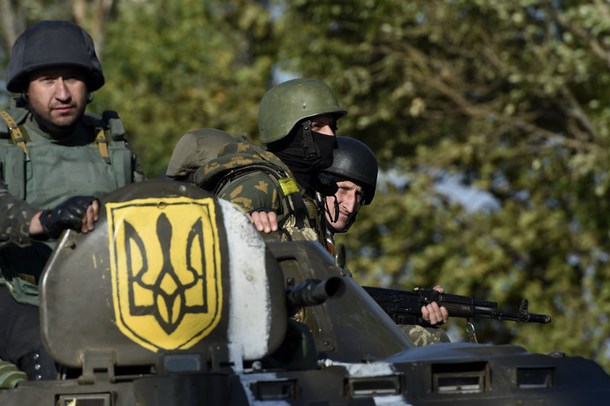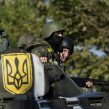
Continued Confrontation With the West Will Prop up Putin’s Regime for Years
Publication: Eurasia Daily Monitor Volume: 12 Issue: 61
By:

A fragile ceasefire is partially holding in Donbas (eastern Ukrainian region encompassing Donetsk and Luhansk provinces). Massive offensive operations have ceased and some heavy weapons have been withdrawn from the front line. But the truce is constantly broken by gun battles and bombardments. The Organization for Security and Cooperation in Europe’s (OSCE) mission, tasked with monitor the truce, reports on the violations but cannot do much else. As the warring parties continue to blame each other, the Russia-backed separatists threaten to resume a large-scale offensive if the ceasefire finally collapses (Interfax, March 21). Andrei Parubiy, the deputy speaker of the Ukrainian Supreme Rada (parliament) and former national security council secretary, recently told journalists: “Russia may begin a massive invasion—it is concentrating forces on the Ukrainian border and [President Vladimir] Putin has far-reaching aggressive military plans” (Newsru.ua, March 26).
A marathon all-night summit of the leaders of Russia, Ukraine, Germany and France in Minsk ended on February 12 with a ceasefire agreement in Donbas and measures to revitalize the original Minsk One accords, signed in September 2014. Despite Minsk Two, the Russian-led forces, apparently including regular Russian army units, continued their offensive against the Ukrainian military in Debaltseve—an important rail and road junction northeast of Donetsk, semi-surrounded by the rebels since last September. On February 18, Ukrainian President Petro Poroshenko ordered his troops to retreat from the Debaltseve bulge (see EDM, February 19).
After the Debaltseve debacle, the ceasefire has more or less held, but other parts of the Minsk Two agreement are essentially stalled. Negotiations between the Moscow-backed rebels and the Ukrainian authorities continue occasionally, in the hopes of revitalizing Minsk Two. This week, a tentative agreement was reached to form four joint working groups to discuss the implementation of different aspects of Minsk Two, but no date was agreed on for these working groups’ first meeting. The Supreme Rada in Kyiv has, on March 17, approved the implementation of “special local self-rule in rebel-controlled parts of Donbas”—a formula seen as a way to partially legalize the Pro-Russia rebels—only after new local elections under Ukrainian law. In a separate resolution, the Rada declared the rebel-controlled part of Donbas “a temporarily occupied territory.” The rebels demand that the Rada resolutions of March 17 must be rewritten, “or the peace process will be blocked.” Poroshenko is calling for the OSCE observers to be reinforced by a United Nations or European Union peacekeeping mission with a stronger mandate—which Moscow and the rebels reject. Both sides are using the Minsk Two accords to dismantle illegal armed formations: The Luhansk rebels have been disarming and arresting members of Russian self-styled Cossack units that refuse to submit to official control. The Ukrainian authorities are urging their various volunteer fighting units to join the army or come under the command of the interior ministry (top.rbc.ru, April 1).
After early warmth and dry sunny days in March, the Russian and Ukrainian flatlands have been recently experiencing a bout of bad weather with renewed snow, ice, rain and storm winds—especially in Donbas and adjoining Russian Rostov oblast. This bad weather could keep the fields in Donbas and other parts of the Russian-Ukrainian border region wet longer than expected, prolonging the notorious Russian “rasputitsa” or spring mud season. Rasputitsa turns Ukrainian and Russian flatlands and unpaved roads into quagmires, seriously hampering offensive war-making. The present wobbly ceasefire will most likely last until the end of the spring mud season; but summer comes soon and, with it—the long months of the potential summer war season. The rebels have, time and again, expressed their dislike for the Minsk Two accord, which has limited their control to only parts of Donbas. They may be seeking a pretext to resume an offensive to capture more land with Russian support (Interfax, March 17). Of course, ultimately, the decision to continue to try to implement Minsk Two and gradually deescalate the conflict, or to renew the fighting and effectively scrap this accord after a temporary wobbly ceasefire, lies with the Kremlin. The rebels know they cannot achieve anything on the battlefield without Russian aid and active participation.
Mikhail Dmitriyev, a well-known economist and deputy minster of economics in Putin’s first government (2000–2004), is renowned in Moscow for the often extreme accuracy of his social-political prognoses, mostly based on focus group research. A recent sociological report, prepared by a team led by Dmitriyev, postulates two basic scenarios for Russia’s domestic politics in the coming years: According to Dmitriyev, more than 80 percent of Russians support Putin and his policy of confrontation with the West over Ukraine, despite the present economic and financial crisis, massive ruble devaluation and runaway inflation. This support is a reaction to a presumed foreign military-political threat—a rallying around the flag and the chief. Hence, if Minsk Two is successful, the fighting in Ukraine will end and “the role of the foreign threat factor will diminish.” Putin’s approval ratings will then slide, economic and social hardships may start to dominate public debate, and mass protests could begin during and after the 2016 Duma elections and the presidential race in 2018—when Putin apparently plans to be reelected for another six years to the Kremlin, until 2024.
The alternative scenario, according to Dmitriyev, is to continue an armed conflict in Ukraine (Donbas). “Defensive patriotism” and the present wartime propaganda will help keep Putin’s approval ratings high: “In an economic crisis, the population could better accept hardships as inevitable and focus its aggressive emotions and frustrations on the external enemy.” Under this second scenario, mass protests seem less probable and Russians may more easily accept rigged elections that could give them an element of stability and presumed security—the same old faces in power (Kommersant, March 31).
It is highly probable that Minsk Two will fail and the confrontation will continue—at least until oil prices begin to climb, as the Kremlin hopes they will. With a renewed flow of petrodollars, the Kremlin could increase social handouts to contain discontent, which in turn could increase consumer confidence and induce economic growth. A continued and escalating confrontation with the United States and the West seems to be Putin’s best insurance policy to maintain his ratings and power through the coming “lean years.” According to former deputy prime minister and financial minister Alexei Kudrin, the Russian economy will stagnate for at least five years, even if long-needed structural reforms begin immediately (Interfax, March 31).




